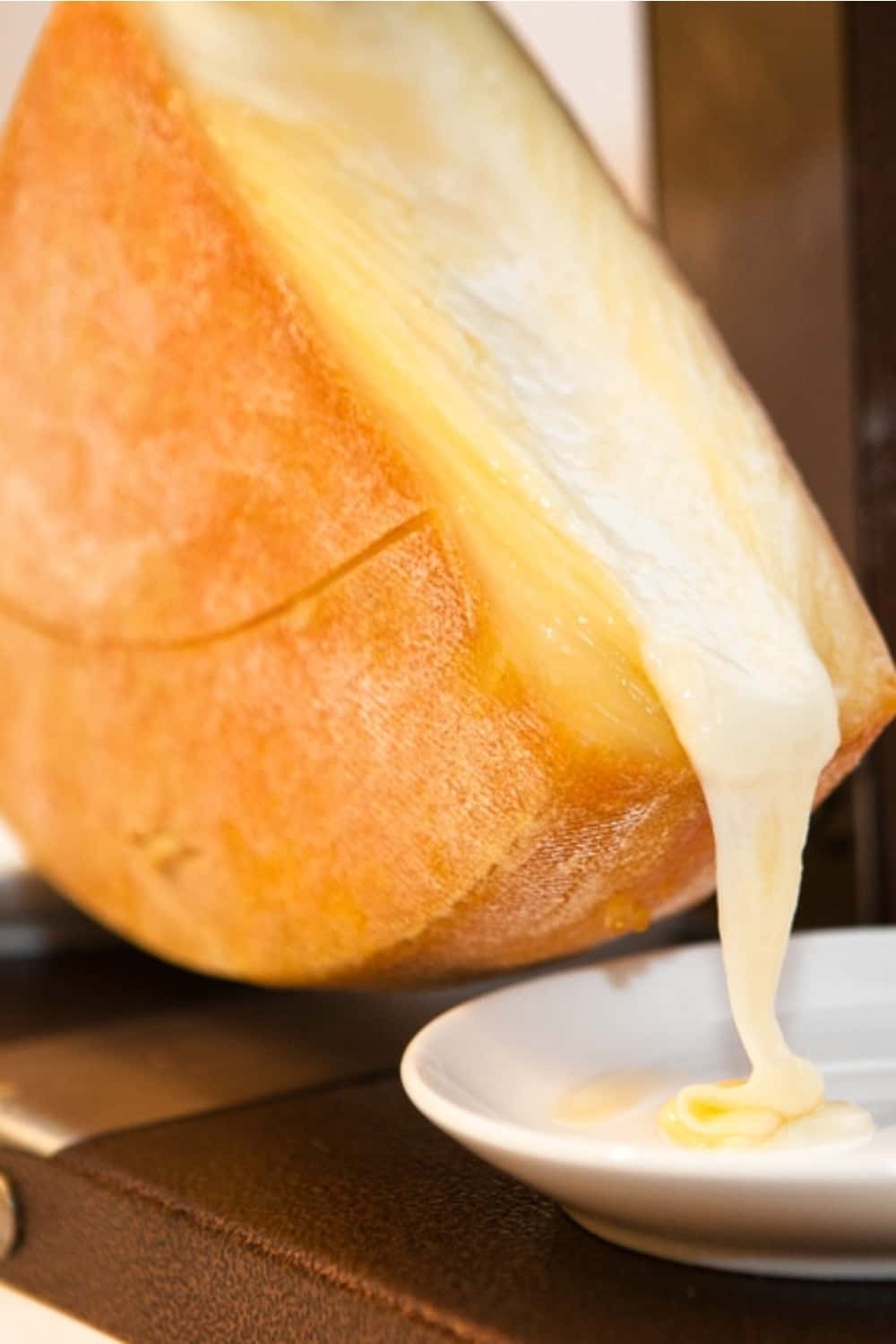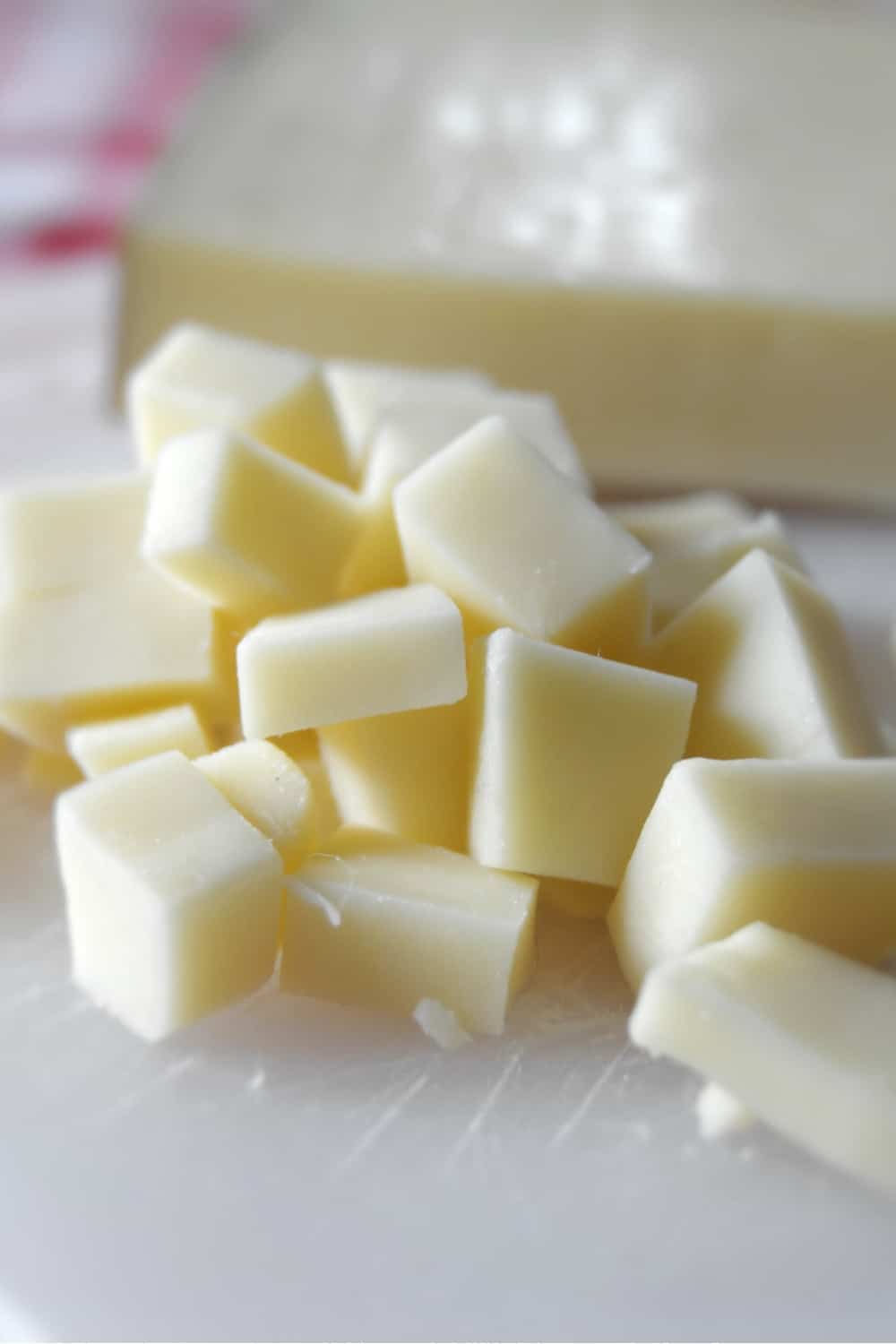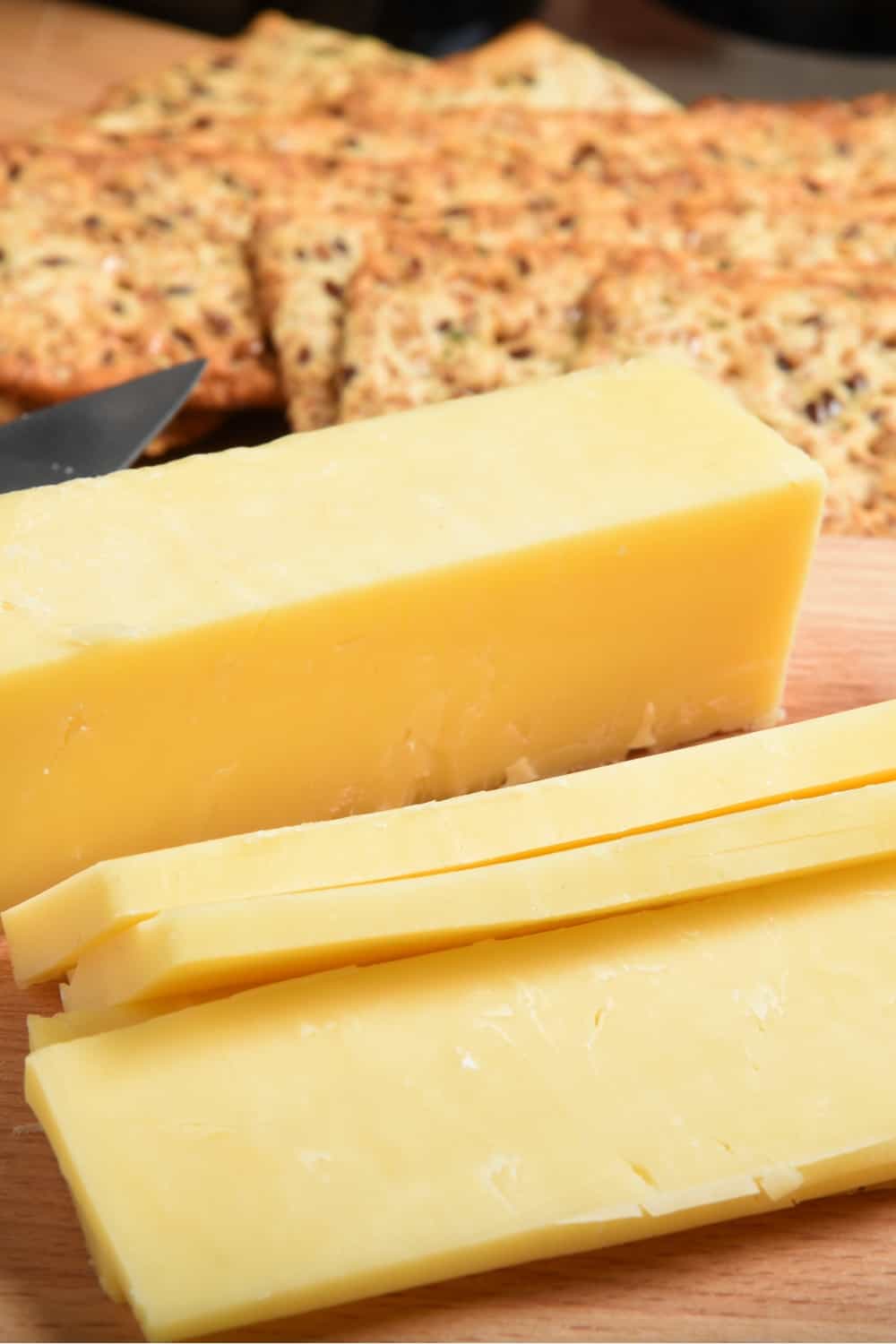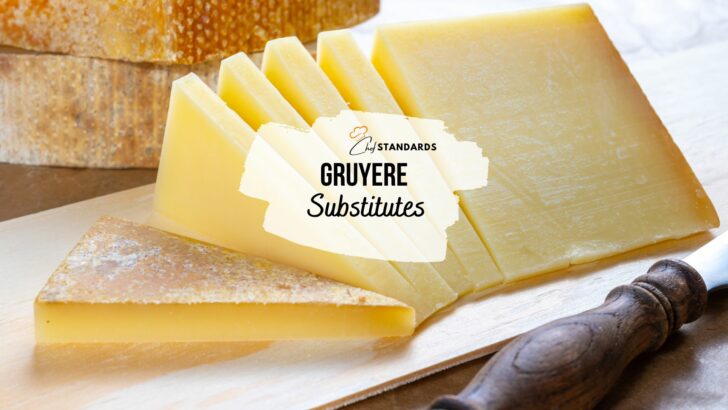The other day I was thinking about making Gruyere mac and cheese (one of my favorite meals) only to realize that I ran out of this cheesy goodness! (*a-long-sigh-of-despair*)
So, I had two options: I could’ve skipped preparing my fav meal OR I could’ve found some other worthy substitutes for Gruyere cheese.
And do you know what I did?
I did my research, and found some mouthwatering Gruyere substitutes that go perfectly with mac and cheese or any other dish.
If you’re facing the same problem (read: if you don’t have any Gruyere cheese on hand), or want to try something new, below you’ll find the 13 finest Gruyere substitutes!
DID YOU KNOW? Gruyere is a hard Swiss cheese named after the town of Gruyères in Fribourg.
1. Raclette cheese

Raclette cheese has its origins in Wallis, Switzerland. It is estimated that this cheese is more than 400 years old, and the first written records of Raclette date back to the early 19th century.
Pros
• Type of cheese: Both Raclette cheese and Gruyere cheese are Swiss cheeses*. Raclette is a semi-hard cheese, whereas Gruyere is a hard cheese.
• Texture: Both Raclette and Gruyere have a creamy texture when young. They are firmer when aged.
• Flavor: Both Raclette and young Gruyere cheese have a mild and nutty flavor. An aged Gruyere has a more earthy taste.
• Melting properties: Both Raclette and Gruyere melt beautifully.
• Availability: Just like Gruyere, Raclette can also be found in larger grocery stores, specialty cheese websites, and gourmet food stores.
• Price: Raclette cheese is a bit cheaper alternative than Gruyere cheese. 1 pound of Raclette cheese costs around $20, whereas 1 pound of Gruyere cheese costs around $28.
• Nutritional value: Raclette cheese has a smaller amount of fat and cholesterol than Gruyere cheese.
• Type of milk: Raclette cheese is made from raw or pasteurized cow’s milk, whereas Gruyere cheese is made from raw cow’s milk.
Cons
There are no cons.
How To Use Raclette Cheese
Roasted or boiled potatoes are a must for Raclette cheese! Raclette cheese is also used in cheese fondue, casseroles, pasta, mac and cheese, sandwiches, frittatas, eggs and truffles, and many others.
Also, make sure to check out a cheese Raclette dinner spread recipe on the video below:
* Swiss cheese is cheese made by the Swiss process or by any other procedure which produces a cheese that has the same properties as cheese produced by the Swiss process. Generally, Swiss cheeses are made from cow’s milk and have holes.
2. Emmental cheese

Emmental, Emmentaler, or Emmenthal has its origins in the area around Emmental, in the canton of Bern in Switzerland. Emmental cheese is known as the “the king of cheese” because a wheel weighs between 75 and 120 kg which equals 165 to 265 pounds.
Pros
• Type of cheese: Both Emmental cheese and Gruyere cheese are Swiss cheeses. Emmental cheese is a semi-hard cheese, whereas Gruyere is a hard cheese.
• Type of milk: Both Emmental and Gruyere are made from raw cow’s milk.
• Flavor: Both Emmental cheese and Gruyere cheese have a mild and nutty flavor.
• Melting properties: Both Emmental and Gruyere are great melting cheeses.
• Price: Emmental cheese is a bit cheaper than Gruyere cheese. 1 pound of Emmental cheese costs around $22, whereas 1 pound of Gruyere cheese costs around $28.
• Nutritional value: Emmental has a bit lower levels of fat content than Gruyere.
• Availability: Both Emmental and Gruyere are widely available in grocery stores, supermarkets, and online shopping websites.
Cons
• Texture: Emmental has a slightly creamier texture than Gruyere cheese when young (which can also be considered as an advantage). Also, Emmental has larger holes of varying sizes, while Gruyere has far less noticeable holes.
How To Use Emmental Cheese
Given that Emmental cheese has excellent melting properties, it is ideal for any dish that calls for melted cheese (e.g. casseroles, cheese fondue, grilled cheese sandwiches, pasta, gratins, etc.). You can also serve this cheese with fruit and nuts. Additionally, here are some great Emmental cheese substitutes suitable for any dish.
3. Fontina cheese

Fontina cheese has its origins in the Valle d’Aosta region of northern Italy. The name Fontina refers to the tiny village of Fontinaz in that region.
Pros
• Texture: Both Fontina and Gruyere have a creamy texture when young. They are firmer when aged.
• Type of milk: Both Fontina cheese and Gruyere cheese are made from raw cow’s milk.
• Flavor: Both Fontina cheese and Gruyere cheese have a mild, nutty flavor.
• Melting properties: Both Fontina and Gruyere melt beautifully.
• Availability: Just like Gruyere, Fontina can also be found in grocery stores, supermarkets, and online shopping websites.
• Price: Fontina cheese is a bit cheaper than Gruyere cheese. 1 pound of Fontina cheese costs around $25, whereas 1 pound of Gruyere cheese costs around $28.
• Nutritional value: Fontina cheese and Gruyere cheese have the same amount of fat. Also, Fontina cheese has a bit higher levels of proteins than Gruyere cheese.
Cons
• Type of cheese: Fontina cheese is a semi-hard Italian cheese, while Gruyere cheese is a hard Swiss cheese.
How To Use Fontina Cheese
Fontina cheese is best used in the following dishes: cheese fondue, casseroles, baked cheese dips, pasta, mac and cheese, chicken Valdostano, sandwiches, frittatas, eggs and truffles, and many others.
4. Comte cheese

Comté cheese originated from the Jura Mountains in the western portion of the French Alps. In the 13th century, Comte was produced in “fruitieres” where a group of farmers shared the milk collected on a daily basis.
Pros
• Texture: Both Comte and Gruyere have a soft and creamy texture when young and firmer texture when aged.
• Type of milk: Both Comte cheese and Gruyere cheese are made from raw (unpasteurized) cow’s milk.
• Flavor: Comte cheese and Gruyere cheese share a mild, nutty and slightly sweet flavor with buttery undertones.
• Melting properties: Both Comte and Gruyere cheeses have wonderful melting properties which is why they’re favorite among chefs.
• Availability: Just like Gruyere, Comte can also be found in grocery stores, supermarkets, and online shopping websites.
• Price: Comte cheese and Gruyere cheese have similar prices. 1 pound of Comte cheese costs around $26, whereas 1 pound of Gruyere cheese costs around $28.
• Nutritional value: Comte and Gruyere have similar amounts of fat and proteins.
Cons
• Type of cheese: Comte cheese is a semi-hard French cheese, whereas Gruyere cheese is a hard Swiss cheese.
How To Use Comte Cheese
Comte is perfect for bread rolls, scones, pancakes, sandwiches, quesadillas, pizzas, mac-n-cheese, pasta, cheese fondue, and many others. If you’re interested in making a delicious fondue with Comte, then check out the video below:
5. Beaufort cheese
Beaufort cheese originated from Savoie in the Rhône-Alpes region of France.
FUN FACT: In order to make a Beaufort cheese of 40-45 kg, you’ll need 130 gallons of milk. WOW, that’s a lot!
Pros
• Type of cheese: Both Beaufort and Gruyere are hard cheeses. Beaufort is an Alpine cheese and it belongs to the Gruyere family.
• Type of milk: Both Beaufort and Gruyere are made from raw cow’s milk.
• Texture: Similarly to Gruyere, Beaufort has a smooth and creamy texture when young. Also, Beaufort cheese doesn’t have holes.
• Melting properties: Both Beaufort and Gruyere melt easily.
• Price: Beaufort cheese and Gruyere cheese have similar prices. 1 pound of Beaufort cheese and Gruyere cheese costs around $28.
• Nutritional value: Beaufort and Gruyere have similar amounts of fat content and proteins.
• Availability: Both Beaufort and Gruyere can be found in larger grocery stores, specialty cheese websites, and gourmet food stores.
Cons
• Flavor: Beaufort has a more subtle buttery flavor than Gruyere cheese.
How To Use Beaufort Cheese
Beaufort cheese has great melting properties, and, therefore, is ideal for any dish that requires melted cheese such as cheese fondue, casseroles, grilled cheese sandwiches, pasta, and gratin. You can also use it as a cheese topping or eat it as a snack.
6. Appenzeller cheese

Appenzeller cheese is produced in the Appenzellerland region of northeast Switzerland.
Pros
• Type of cheese: Both Appenzeller cheese and Gruyere cheese are hard Swiss cheeses.
• Type of milk: Both Appenzeller cheese and Gruyere cheese are made from raw (unpasteurized) cow’s milk.
• Texture: Both Appenzeller and Gruyere have a soft and creamy texture when young and firmer texture when aged.
• Flavor: Appenzeller cheese and Gruyere cheese share a mild, nutty and fruity flavor.
• Melting properties: Both Appenzeller and Gruyere cheeses have wonderful melting properties.
• Availability: Both Gruyere and Raclette can also be found in larger grocery stores, specialty cheese websites, and gourmet food stores.
• Price: Appenzeller cheese and Gruyere cheese have similar prices. 1 pound of Appenzeller and Gruyere cheese costs around $28.
Cons
• Nutritional value: Appenzeller cheese and Gruyere cheese have similar amounts of fat, but Appenzeller cheese has a lower amount of protein.
How To Use Appenzeller Cheese
Appenzeller is perfect for potatoes, salads, sandwiches, quesadillas, pizzas, mac-n-cheese, pasta, cheese fondue, and many others.
7. Jarlsberg cheese

Jarlsberg cheese is a mild cheese made in Norway, and its secret recipe has been the same since 1956. It has a similar taste to Gruyere which makes it a great alternative.
Pros
• Type of cheese: Both Jarlsberg cheese and Gruyere cheese are Swiss cheeses. Jarlsberg is a semi-hard cheese, whereas Gruyere belongs to a hard type of cheese.
• Flavor: Both Jarlsberg and Gruyere cheeses have a mild, nutty and slightly sweet flavor.
• Melting properties: Both Jarlsberg and Gruyere cheeses melt beautifully due to their high water-to-oil ratio.
• Availability: Both Jarlsberg and Gruyere can be found in larger grocery stores, specialty cheese websites, and gourmet food stores.
• Price: Jarlsberg cheese is a cheaper alternative than Gruyere cheese. 1 pound of Jarlsberg cheese costs around $20, whereas 1 pound of Gruyere cheese costs around $28.
• Nutritional value: Jarlsberg cheese has lower levels of fat and cholesterol than Gruyere cheese.
Cons
• Texture: Jarlsberg has a semi-firm yellow interior with a creamier texture than Gruyere when young (which can also be considered as an advantage).
• Type of milk: Jarlsberg cheese is made from pasteurized semi-skimmed cow’s milk, while Gruyere cheese is made from whole (raw) cow’s milk that hasn’t been pasteurized.
How To Use Jarlsberg Cheese
Jarlsberg is a versatile cheese perfect for sandwiches, quesadillas, pizzas, or burgers. You can also use it for a delicious mac-n-cheese, or pour it over bread and apples for a fondue. The choice is yours! If you need a simple recipe for a Jarlsberg cheese dip, you’ll find it on the video below:
8. Parmesan cheese
It is believed that Benedictine monks who lived in the Parma-Reggio region of Italy (around 900 years ago) created Parmesan cheese for the sake of extending the shelf life of the large quantity of milk they were producing.
Pros
• Type of cheese: Parmesan is a hard Italian cheese, whereas Gruyere is a hard Swiss cheese.
• Type of milk: Parmesan is made from raw or pasteurized cow’s milk, whereas Gruyere is made from raw cow’s milk.
• Melting properties: Both Parmesan and Gruyere can be melted. However, grated Parmesan doesn’t melt as easily.
• Price: Parmesan cheese and Gruyere cheese have similar prices. 1 pound of Parmesan cheese and Gruyere cheese costs around $28.
• Nutritional value: Parmesan has more proteins and lower levels of fat and cholesterol than Gruyere.
• Availability: Both Parmesan and Gruyere are widely available in grocery stores, supermarkets, and online shopping websites.
Cons
• Texture: Parmesan cheese has a hard, gritty texture, whereas Gruyere cheese has creamier texture.
• Flavor: Parmesan cheese has a stronger and nuttier flavor than Gruyere cheese.
How To Use Parmesan Cheese
Parmesan cheese is mostly used grated over pastas or in soups and risottos. It is also eaten on its own as a snack.
9. Cheddar cheese

Apart from being one of the best cheeses for tacos, cheddar is also a great substitute for Gruyere. Cheddar originated in the southwestern county of Somerset, England. Here’s one FUN FACT that might interest you: The US produced around 3.4 billion pounds of cheddar in 2015.
Pros
• Type of cheese: Both Cheddar and Gruyere are hard cheeses.
• Type of milk: Both Cheddar cheese and Gruyere cheese are made from raw (unpasteurized) cow’s milk.
• Melting properties: Both Cheddar and Gruyere cheeses melt extremely well.
• Availability: Both cheeses can be found in grocery stores, supermarkets, and online shopping websites.
• Price: Cheddar cheese is a bit cheaper than Gruyere cheese. 1 pound of Cheddar cheese costs around $24, whereas 1 pound of Gruyere cheese costs around $28.
Cons:
• Flavor: Cheddar cheese has a sharp and salty flavor, whereas Gruyere cheese has a nutty, earthy flavor.
• Texture: Cheddar cheese has a crumbly texture, whereas Gruyere cheese has a smoother texture.
• Nutritional value: Cheddar cheese and Gruyere cheese have the same amounts of fat. However, Cheddar cheese has a lower amount of protein.
How To Use Cheddar Cheese
Cheddar is one of the best cheeses to use for grilled cheese sandwiches. It also goes well with mac and cheese, potatoes, pasta, burgers, and salads.
10. Provolone cheese

Provolone cheese first appeared in the late 1800s in the Lombardy and Veneto regions of the Po River Valley of Italy.
Pros
• Texture: Provolone has a creamy texture like Gruyere when young.
• Type of milk: Provolone cheese is made from raw or pasteurized milk, and Gruyere cheese is made from raw cow’s milk.
• Availability: Just like Gruyere, Provolone can also be found in larger grocery stores, specialty cheese websites, and gourmet food stores.
• Price: Provolone cheese is much cheaper than Gruyere cheese. 1 pound of Provolone cheese costs around $15, whereas 1 pound of Gruyere cheese costs around $28.
• Nutritional value: Provolone cheese has lower amounts of fat and cholesterol than Gruyere cheese.
Cons
• Type of cheese: Provolone cheese is a semi-hard Italian cheese, while Gruyere cheese is a hard Swiss cheese.
• Flavor: Provolone cheese has a mild, smoky flavor that is less aromatic. Gruyere cheese has a mild, nutty flavor.
• Melting properties: Unlike Gruyere, Provolone cheese doesn’t have a good meltability.
How To Use Provolone Cheese
Provolone cheese is best used for grilled sandwiches, casseroles, pizzas, baked pasta dishes, salads, and desserts. It is a great alternative for Mozzarella cheese as well. Here’s one simple and tasty Provolone cheese recipe on the video below:
11. Edam cheese
Edam cheese has its origins in the Edam region of the Netherlands.
Pros
• Flavor: Both Edam cheese and Gruyere cheese have a mild and nutty flavor when young and they become sharper when aged.
• Melting properties: Both Edam and Gruyere are great melting cheeses.
• Price: Edam cheese is much cheaper than Gruyere cheese. 1 pound of Edam cheese costs around $5, whereas 1 pound of Gruyere cheese costs around $28.
• Nutritional value: Edam cheese has lower levels of fat and cholesterol than Gruyere cheese.
• Availability: Both Edam and Gruyere are widely available in grocery stores, supermarkets, and online shopping websites.
Cons
• Type of cheese: Edam is a semi-hard Dutch cheese, whereas Gruyere is a hard Swiss cheese.
• Type of milk: Edam cheese is made from pasteurized cow’s or goat’s milk, whereas Gruyere is made from raw cow’s milk.
• Texture: Edam cheese has a smooth, firm texture, whereas Gruyere cheese has a creamier texture when young.
How To Use Edam Cheese
Edam cheese is ideally used for pasta dishes, potato dishes, baked egg casseroles, or lasagna.
12. Gouda cheese

Gouda cheese originated in the southern regions of the Netherlands.
Pros
• Melting properties: Both Gouda and Gruyere melt easily.
• Availability: Just like Gruyere, Gouda can also be found in grocery stores, supermarkets, and online shopping websites.
• Price: Gouda cheese is a bit cheaper than Gruyere cheese. 1 pound of Gouda cheese costs around $25, whereas 1 pound of Gruyere cheese costs around $28.
• Nutritional value: Gouda cheese has a smaller amount of fat than Gruyere cheese.
Cons
• Type of cheese: Gouda is a semi-hard Dutch cheese, while Gruyere is a hard Swiss cheese.
• Flavor: Gouda cheese has an aromatic and caramel flavor, whereas Gruyere cheese has a mild, nutty flavor.
• Texture: Gouda cheese has a more elastic texture than Gruyere cheese.
• Type of milk: Gouda cheese is typically made from pasteurized milk, while Gruyere cheese is made from raw cow’s milk.
How To Use Gouda Cheese
Gouda cheese is best used in the following dishes: mac and cheese, fondue, soups, mashed potatoes, and grilled cheese sandwiches.
Final Thoughts
I hope the above list helped you find the best replacement(s) for Gruyere cheese according to your dish and preferences.
You cannot go wrong with any of the suggested substitutes, but still make sure that it fits the type of meal you’re preparing.


